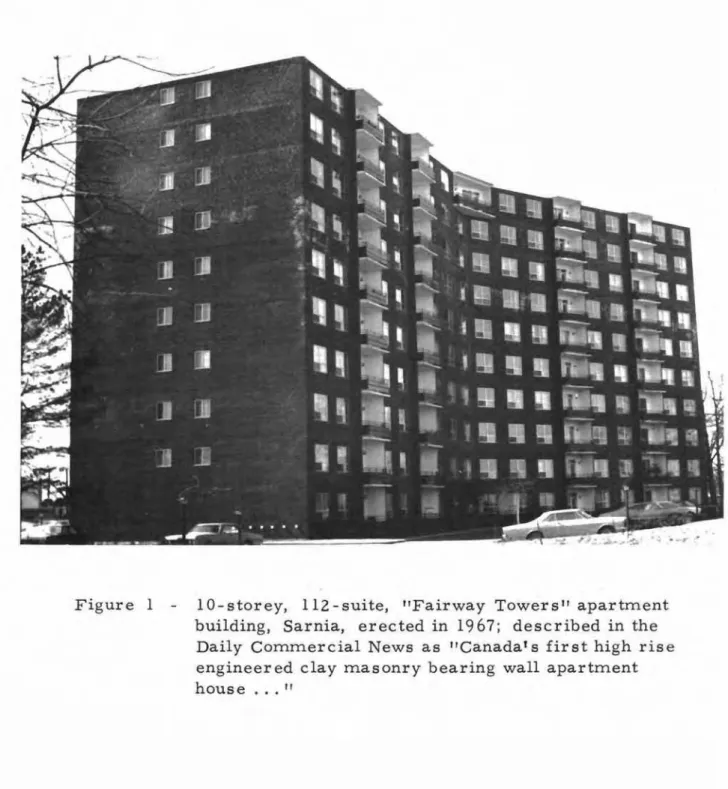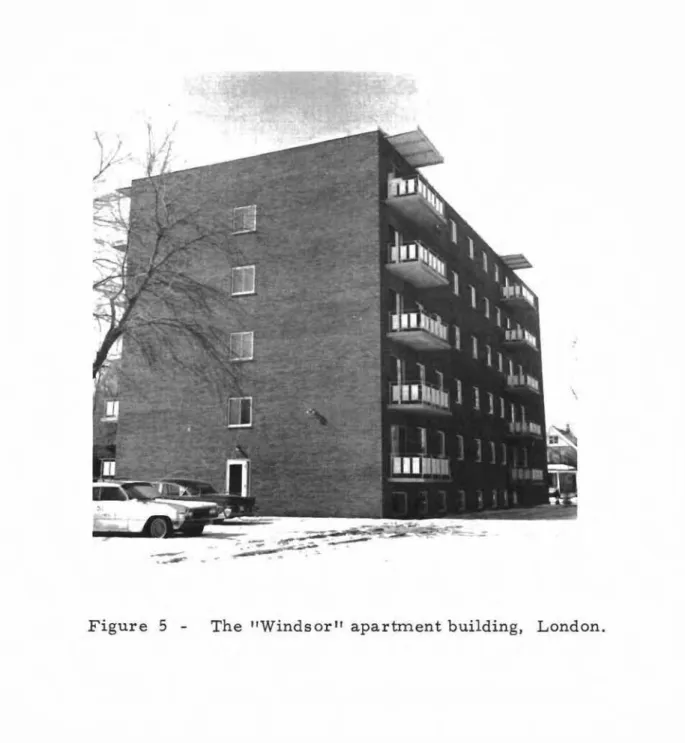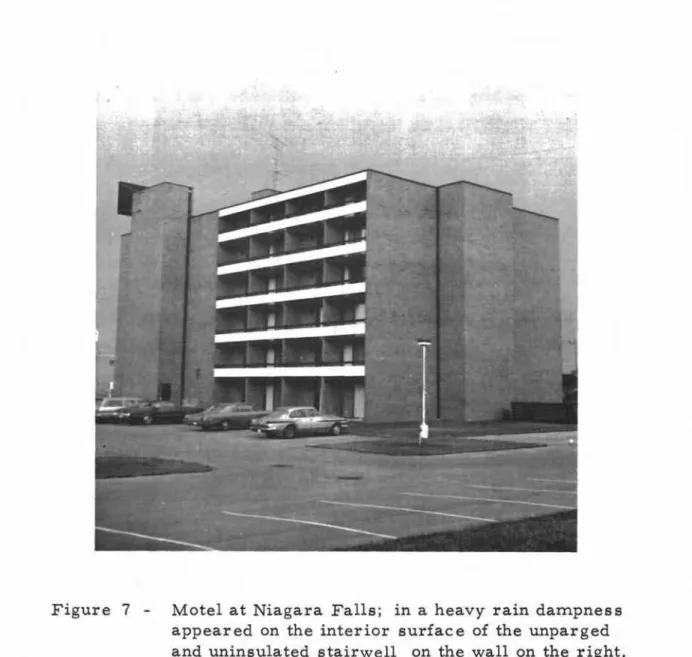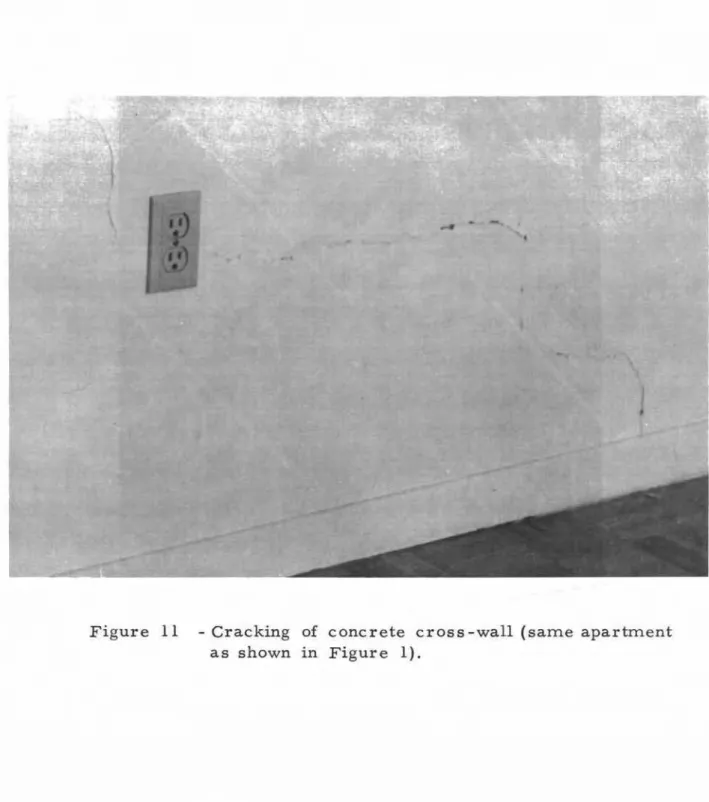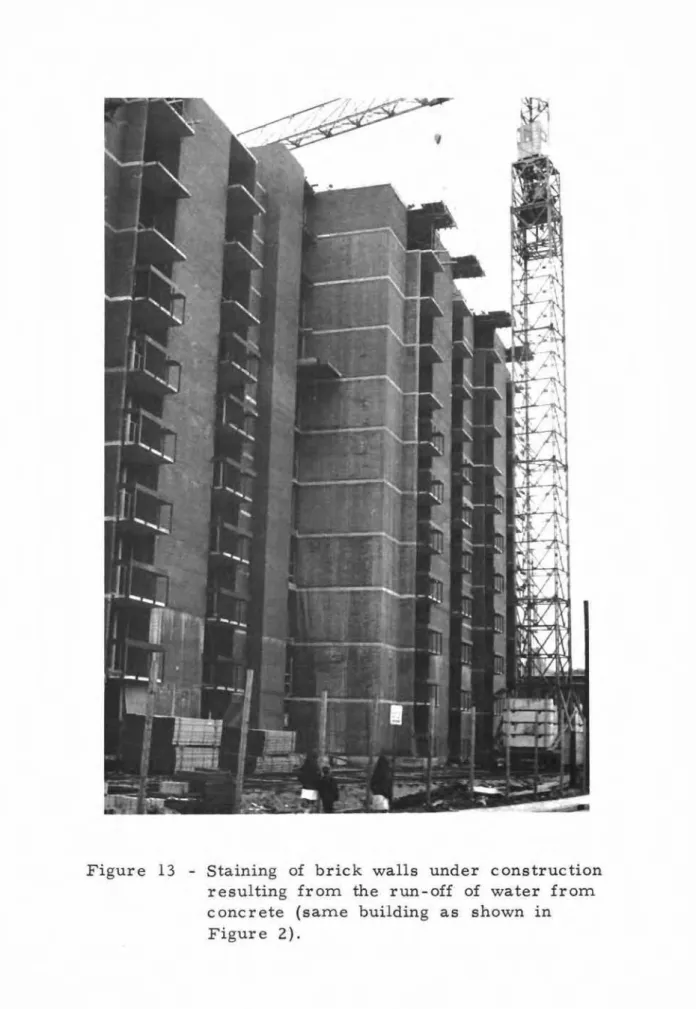Publisher’s version / Version de l'éditeur:
Vous avez des questions? Nous pouvons vous aider. Pour communiquer directement avec un auteur, consultez la première page de la revue dans laquelle son article a été publié afin de trouver ses coordonnées. Si vous n’arrivez pas à les repérer, communiquez avec nous à PublicationsArchive-ArchivesPublications@nrc-cnrc.gc.ca.
Questions? Contact the NRC Publications Archive team at
PublicationsArchive-ArchivesPublications@nrc-cnrc.gc.ca. If you wish to email the authors directly, please see the first page of the publication for their contact information.
https://publications-cnrc.canada.ca/fra/droits
L’accès à ce site Web et l’utilisation de son contenu sont assujettis aux conditions présentées dans le site
LISEZ CES CONDITIONS ATTENTIVEMENT AVANT D’UTILISER CE SITE WEB.
Internal Report (National Research Council of Canada. Division of Building
Research), 1970-11-01
READ THESE TERMS AND CONDITIONS CAREFULLY BEFORE USING THIS WEBSITE. https://nrc-publications.canada.ca/eng/copyright
NRC Publications Archive Record / Notice des Archives des publications du CNRC :
https://nrc-publications.canada.ca/eng/view/object/?id=fe7f2a32-9184-4fe6-9fa7-8a71fb4dc394 https://publications-cnrc.canada.ca/fra/voir/objet/?id=fe7f2a32-9184-4fe6-9fa7-8a71fb4dc394
NRC Publications Archive
Archives des publications du CNRC
For the publisher’s version, please access the DOI link below./ Pour consulter la version de l’éditeur, utilisez le lien DOI ci-dessous.
https://doi.org/10.4224/20331493
Access and use of this website and the material on it are subject to the Terms and Conditions set forth at
Performance of "T.T.W." brick buildings
DIVISION OF BUILDING RESEARCH
PERFORMANCE OF "T. T. W." BRICK BUILDINGS
by
T. Ritchie
ANAL YZED
Internal Report No. 380
of the
Division of Building Research
OTTAWA November 1970
PREFACE
Single -leaf "T, T. W.
'I
(through-the-wall) brick walls, extensively used in recent years by the building industry of southern Ontario and to a lesser extent by builders elsewhere in Canada, have been employed as the non-load-bearing en-closing walls of buildings of structural frame construction and as the load-bearing walls of buildings up to 13 storeys in height.Many papers and reports in the building science liter-ature describe structural properties of single-leaf brick walls, but few reports deal with the weather resistance of such walls. Accordingly when the Canadian Structural Clay Association re-quested DBR to undertake laboratory studies of rain leakage of
T. T. W. brick walls it was decided that a useful preliminary step would be the examination of a number of buildings of this construction. It was considered that such a study, even if
undertaken mainly to determine the nature and extent of leak-age problems, would also provide useful information on the materials and current practices of T. T. W. brick construction.
The survey, carried out with the co-operation and as-sistance of the Canadian Structural Clay Association (3. F. Cutler, Managing Director) is described in this report.
OTTAWA
November 1970
N. B. Hutcheon Director
by T. Ritchie
The survey reported here was undertaken at the request of the Canadian Structural Clay Association to determ.ine if the problem. of rain penetration has occurred in buildings of "T. T. W." ("through-the-wall") brick construction, and, if so, what features of design and construction contributed to the problem.. An additional purpose of the survey was to obtain general inform.ation concerning the practices of construction using T. T. W. bricks. The buildings inspected in the survey were selected from. the listings and inform.ation com.piled by J. F. Cutler, Managing Director of the Canadian Structural Clay As sociation, who accom.panied the author during the survey. They are located in several cities, including Metropolitan Toronto, Ham.ilton, London, Niagara Falls, St. Catharines and Sarnia. T. T. W. BRICKS
T. T. W. bricks, designed to provide in one unit the required thickness of a wall exclusive of any finishing such as plaster or in-sulation, are m.odular in size. The length is nom.inally 12 in. and the width either 6 or 8 in.; the height is 2t in., the sam.e as that of a conventional brick. The volurn.e of a 6-in. T. T. W. brick accordingly is m.ore than twice that of a conventional m.odular brick, while an
8-in. T. T. W. brick has three tim.es its volurn.e. Each T. T. W. brick laid in a wall thus provides greater volum.e than that of a conventional m.odular brick.
The 6-in. T. T. W. brick is essentially the "S. C. R." brick developed in the U.S.A. in 1952 by the Structural Clay Products Research Foundation for the construction of houses. Its m.anufacture in Canada for this m.arket, however, appears to have m.et with limited success, but large-scale use of the brick has developed in recent years for the construction of large buildings. The T. T. W. brick has been used in buildings of reinforced concrete and steel frames for the non-load-bearing walls and panels which enclose the building, while
another im.portant and interesting use of the brick is for load-bearing walls in engineered masonry construction, a structural application of brickwork which was provided for in the 1965 edition of the National Building Code of Canada. In engineered masonry applications T. T. W. bricks were used in 1965 in a few 5- and 6-storey buildings, followed in 1967 by the construction of a lO-storey apartment containing m.ore
2
-than 100 suites (Figure 1). More recently, a large 13-storey apa r trn errt building has been erected of unreinforced T. T. W. brick walls which pro-vide the structural capacity of the building.
STRUCTURAL BRICK MASONRY
The use of relatively thin but strong brick walls to provide the structural capacity of high-rise buildings was started in Switzerland in the 1950's when znany 13- to 18-storey buildings of unreinforced brick walls were constructed. Soon afterwards structural brickwork was being used extensively elsewhere in Europe, and eventually was introduced to Canada, as described briefly in DBR Visit Report No. 57, prepared in Nov errib e r , 1968.
The rnain econoznic advantage of using structural rria s on r y walls is the e l irrrina ti on of a structural fr arn e of reinforced concrete or steel f'r orn the building. To achieve this purpose structural rna s on ry cross-walls rnu st be coznbined with rigid floor e l.ern.errta to provide the necessary rigidity to the structure. The design of the walls mu st enable th arn to resist lateral loads applied to the building that are transznitted to the cross-walls by zneans of the floor slabs, and the walls, of course,
rnu st be designed to carry, in addition to the lateral loads, all the verti-cal loads irrip o s ed on the building. Where walls adjoin, as when cross-walls rrie et the p e r irn e te r walls, they are usually connected structurally by rn e an s of heavy steel ties, rather than by brick bonding units. Walls of engineered T. T. W. brickwork generally consist of bricks exceeding 8, 000 psi c ornp r e s s iv e strength, laid in strong rn o r ta r such as Type "M" or Type "S" of C. S. A. Specification Al79. In the upper storeys of znany buildings where the walls are subjected to lighter loads than those below, walls of concrete block ma s onry have frequently been used in place of T. T. W. brick walls.
STRUCTURAL BRICKWORK AS A SYSTEM OF BUILDING
The acceptance by the building industry of structural T. T. W. brick rna s onr y, as well as that of other rria s on r y including conventional brick and concrete block, has been due to the econoznic advantage of frazneless construction as well as to the fact that such construction pro-vides a convenient "systezn" of building. The sys tern involves coznpleting the building's foundation, placing the rna s on ry walls of the first storey, laid up to storey height on it, and then laying the floor on top of that. The walls of the next storey, positioned directly over the walls of the storey beneath th erri are then built on the floor, which znay be precast concrete slabs or reinforced concrete cast in place, the latter frequently cast on steel pans over steel joists. The c orrip l etion of the walls and floor of a storey rria k e s it ready for the installation of p lumb ing and electrical
services, partitions and finishing; accordingly, a rational "flow" of work may be scheduled and conveniently organized to follow the operations of bricklaying and flooring.
A 10-storey apartment structure 300 feet in length (Figure 2), that was under construction in Hamilton when examined during the survey, provides an example of the T. T. W. building system. Each storey of this building, according to the construction superintendent, made use of 52, 000 T. T. W. bricks; the more than half -million bricks in the building were laid by 9 bricklayers, with the assistance of 4 labourers and the mortar-mixer operator. The rate of construction was such that each storey of the building (walls and floor slab) was completed within 10 days, even though much of the wall construction on this particular building was carried out in the winter months by bricklayers who had not previously laid
T. T. W. bricks.
WALL CONSTRUCTION
The construction of exterior walls of T. T. W. bricks generally appears to follow the practices illustrated in Figure 3; the construction involves the parging with
i-
to 3/ 8-in. mortar of the back surface of the brickwork, to which is applied rigid boards of foamed plastic insulating material 1 or more inches thick, stuck to the parging by means of an ad-hesive. Gypsum wallboard, 3/8 in. thick nailed to wooden strips at top and bottom, is then stuck to the insulation by means of an adhesive. Plaster, applied directly to the insulation,has also been used in the construction. The painted wallboard or plaster forms the interior finish of the wall.Interior walls of T. T. W. bricks, which do not require parging or insulation, may be finished with wallboard, but in many buildings the brickwork itself has been used as the wall finish. In addition to economic advantages it has many desirable features including attractive colour, tex-ture, and low maintenance resulting from the brickwork's high degree of resistance to damage and disfigurement. In a few such cases bricks have been used to provide a wall with both surfaces finished as soon as the bricks are laid. In many buildings of T. T. W. brick construction corridor walls and walls separating dwelling units are of brick finish (Figure 4). SCOPE OF THE SURVEY
Since T. T. W. brick construction is a relatively recent development in building, the structures examined in the survey have been in service only a few years, many of them in fact, having corne into service during the year of the survey (1970). Of the 45 buildings examined, 9 were under construc-tion at the time of the visit. In all except four the brick walls were load-bearing.
4
-The information obtained about the performance of a particular building was provided by its caretaker and, in many cases, by the representative of the company that supplied bricks for the building. During that part of the survey made in London, for example, much information on the location, construction, and performance of buildings was obtained from Mr. F. Rinker, representing the Canada Brick Company of Streetsville, while in St. Catharines similar information was provided by Mr. G. Goodman of Burnstein Brick Ltd , , St. Ca tha r irie s ,
LEAKAGE PROBLEMS
Of the 36 completed buildings examined 22 were reported to have experienced no rain leakage or dampness problems. No information was available on the performance of four buildings, leaving lOin which rain penetration or dampness had occurred. These 10 buildings included the "Windsor" Apartments, William St., London (Figure 5), a 5 -storey structure erected in 1965 in which one apartment on the east-facing wall had some plaster fall only three years after construction. Accord-ing to the caretaker of the buildAccord-ing the plasterer makAccord-ing repairs
at-tributed the failure to dampness in the wall resulting from rain penetration, although no free water or water stains were observed on the wall. The caretaker stated that no further plaster failure has occurred.
The caretaker of another apartment building, the 5 - storey "Wellington Towers" on Wellington Rd. near Baseline Rd. in London, reported that leakage had taken place on occasion near a window of one of the apartment units but that the problem was restricted to this one location.
The three 7 -storey apartment blocks that comprise "Northpark Towers" on Belfield St., London, erected in 1967, were reported to have experienced leakage problems, particularly in the penthouses where the walls lack parging and insulation. Leakage problems were also reported to have occurred in the apartment buildings of the "Regency Towers" development in London, where in one instance of leakage the water was believed to have entered through the corner of the building. The lack of resistance to rain penetration in this area of the wall was attributed to "toothing" of the walls during construction. "Toothing" results when one wall is built up in advance of the adjoining wall whose bricks are subsequently fitted into the toothing of the first wall, a method of con-struction which makes it difficult to achieve good bond between mortar and brick (Figure 6). This particular problem was reported to have been corrected by replacing the original parging and refinishing the wall.
Another example of leakage, involving a 6-storey motel (Figure 7) erected at Niagara Falls in 1968, was reported by the clerk who stated that leakage had occurred during the early life of the building where the
one-storey restaurant wing joins the remainder of the building; leakage had not been a problem elsewhere. At the time of our visit, however, when heavy rain fell several damp spots were observed on the inner wall surface of a stairwell of brickwork without plaster or insulation; seven small areas of dampness had formed on the inner surface of the stairwell through all 6 storeys of the building. There was no indication of rain penetration through the parged and insulated exterior wall of a room ad-jacent to the stairwell.
The leakage problems affecting the buildings investigated did not appear to follow a general pattern by which the problems could be related to any particular feature of the buildings' design or construction, except, perhaps, that walls that lack parging and insulation, such as those in penthouses and stairways, appear to be more susceptible to rain pene-tration than walls that have parging and insulation, a situation that would be expected.
An interesting observation was made by one person interviewed who stated that the incidence of leakage problems in buildings of T. T. W.
bricks was no more extensive than in buildings of other constructions. Accordingly this aspect of building performanc e should not influenc e the builder to choose another type of building construction over that of T. T. W.
bricks, provided the latter offered other advantages. WORKMANSHlP
The standard of workmanship in the construction of the buildings examined during the survey varied greatly. Most of the buildings, for-tunately' were considered to be examples of careful construction, although the brickwork of a few buildings had obviously been laid carelessly. One fault noted in the latter buildings was the extreme variation in the width
of vertical joints which ranged from almost a butt connection of adjoining bricks (Figure 8), to a joint width of about one inch. Incompletely filled joints, both vertical and horizontal, were also noted in the walls of some of the buildings. Both faults undoubtedly adversely influence the weather resistance of the walls and more important, the structural capacity of the walls in load- bearing applications.
In many buildings, even of brickwork that appeared to have been laid with care, non-alignment of vertical joints was noted. This detracted from the appearance of the walls if not from their technical properties. One reason given for the non-alignment of joints was the relatively high individual cost of a T. T. W. brick, which necessitated the use of any parts broken from a whole brick, these smaller parts being worked into the brickwork wherever convenient thus producing the haphazard appear-ance illustrated in Figure
9.
6
-CRACKS IN BRICKS AND WALLS
Cracks were observed in the exterior walls of several buildings, in some cases passing vertically through bricks and mortar, in others occurring as step-cracks from the corner of the buildings. In one in-stance a crack extended horizontally several feet along a mortar joint separating the bricks and mortar. The causes of the cracks were not determined.
Cracking of individual bricks in one building was particularly extensive (Figure 10), the cracks apparently having been present in the bricks before they were laid. This particular building also had many verti-cal cracks in the horizontal mortar joints. In a few other buildings some of the bricks were excessively warped imparting an uneven aspect to the wall su rf'ac e and to the line of the horizontal mortar joints.
Cracking of interior walls was reported to have occurred in some buildings, particularly where cross-walls of concrete block masonry ad-joined the exterior walls. The large apartment building in Sarnia,
pictured in Figure I, showed step-cracking of a concrete wall of the top storey (Figure 11), but the caretaker stated that such cracking was not extensive in the building.
STAINING AND EFFLORESCENCE
Although his building had not been affected by leakage the caretaker of the Sarnia apartment building complained about the effloresc enc e problem. Many of the buildings examined showed efflorescence on the brickwork near concrete balcony slabs (Figure 12), the wetting of the brickwork in this area and the contribution of salts to it by the concrete probably acc ounting for its occurrence.
Concrete floor slabs cast on brick walls frequently resulted in stain-ing of the walls due to moisture runnstain-ing down the wall from the concrete. This effect was seen in a 10 - storey building in Hamilton (Figure 13) that was affected as soon as the concrete of the top floor slab was placed when a high wind blew fluid from the concrete over the forms to run down the
entire height of the walls. The cleaning of walls stained in this way, however, was not considered by the construction superintendent to be a serious problem.
CONCLUSIONS
In recent years a considerable number of buildings have been con-structed in the southwestern part of Ontario with T. T. W. bricks, which have been used for the enclosing walls of structural-frame buildings as well as for the unreinforced load-bearing walls of buildings, one of which has walls 13 storeys high. The large unit volume of a T. T. W. brick (2 to 3 times that of a conventional brick), the possible elimination of the struc-tural frame by using engineered T. T. W. brickwork, the reduced wall
thickness, and other features of the building s y stern of T. T. W. bricks have given it sufficient ec on.orn ic advantages that it has found a place in the current building industry.
In a survey of the use of T. T. W. bricks 45 buildings were exarn iried,
9
of which were under construction when visited. The standard of wor krnarr-ship of the buildings' brickwork was generally high but a few instanc es of very careless work were noted, particularly where rn o r ta r joints were un-filled and vertical rno r ta r joints were inconsistent in width, both faults known to lessen the weather resistance and strength of brick rria s on r y , Of the 36 buildings in service, 22 had experienced no rain leakage p r ob l.ern s while 10 had. The leakage p r obl ern s did not appear to be related to any particular feature of design or construction of the walls, except that when unparged and uninsulated brickwork was used, as in penthouses and stair-wells, its resistance to rain penetration was apparently rnuc h l e s s than that of brick walls that were parged and insulated. The I'toothing" of in-tersecting walls, apparently a COITlITlon practice, s e erns also to introduce a weakness in a waIlts resistance to rain penetration.
In the course of the survey other p r ob l erns besides leakage wer e noted. In SOITle of the buildings exarniried cracking in the walls and in in-dividual bricks and rno r ta r joints was apparent. Efflorescenc e and stain-ing of walls was observed in ITlany buildstain-ings, particularly where the con-crete balcony slab adjoined the walls. These faults, and that of rain
pen-etration, ITlay or ITlay not be experienced rn o r e often in buildings of T. T. W. brick construction than in buildings of any other construction. The possi-bility of such faults occurring in T. T. W. buildings, however, has not deterred builders fr orn using the sys tern ,
It is again noted that buildings of T. T. W. brick construction are a recent d ev el.oprrrerrt in the Canadian building industry, so recent that none of the structures examined in this survey was rno r e than 5 years old. It r erna in s to be seen if p r ob l ern s other than those described, e. g., dura-bility p r ob l ern s, will arise with T. T. W. brickwork, the p e r fo r rria nc e of which, even though satisfactory in rnany buildings at present, rria y well change as a result of l ongc te r m exposure to the weather, as well as a
result of the Iongc te r m d irn en siona.l changes of the rria te r ia l s . It would
be useful, therefore, to e xarriin e periodically the buildings seen in this survey to d e te r rnin e if changes occur in their p e rf o r rria.nc e over a long period of t.irn e ,
Figure 1 lO-storey, lIZ-suite, "Fairway Tower s " a pa r trn errt building, Sarnia, erected in 1967; described in the Daily Cornrn e r c ia.I News as "Canadafs fir st high rise
engineered clay rna s on ry bearing wall apa r trn erit house ... "
. / WOOD NAILER ""_ AT CEILING NセセセZMョ
:
. . . ...Nセ セ ZOセG ZZZ セN セN ZN ZN
::U-- '--II
.'.
: :.: :: °0::° 0:. : ; : :. : ... ...... .
:.
:
セ ZZ
':..:..>.::.::
. 0 °0 ' 'WOOD NAILER AT FLOORFIGURE 3
EXTERIOR WALL CONSTRUCTION
rn o te l in Niagara Falls; the floors consist of post-tensioned beams made up of concrete blocks, the rough-textured faces of which form the ceiling surface. An external view of this building is given in Figure 7.
Figure 7 - Motel at Niagara Falls; in a heavy rain dampness appeared on the interior surface of the unparged and uninsulated stairwell on the wall on the right.
Figure 9 Irregular bonding produced by the use of bricks of non-uniform length.
Figure 11 - Cracking of concrete cross -wall (saIne apa r tm erit as shown in Figure 1).
Figure 13 - Staining of brick walls under construction resulting from the run-off of water from concrete (same building as shown in Figure 2).
BUILDINGS EXAMINED DURING THE SURVEY
ADDRESS
Richmond St. at Elizabeth St; , Richmond Hill
444 Lumsden Ave. E., Toronto
North Service Rd. of Q. E. Highway, east of #10 Highway, south of Brampton
Queensway Rd. at #10 Highway, south of Brampton
6th Line Road, Oakville Talbot St. at Albert St. London ("Meredith House") Talbot St. , London
("Barclay Towers") Albert St. , London (Old Personsl Horne)
William St. , London ("The Windsor") Adelaide St. N., London Belfield St. , London ("Northpark Towers") Huron St. at Briarhill St. "Regency Towers", London (address not recorded)
80 King Edward St., London ("Barry View Towers") Waterloo St. N., London Oxford St. , London ("Westwood Park")
FUNCTION NO. OF YEAR OF
STOREYS CONSTRUCTION Apartment 7 1969 (l) Apartment 16 NLB(*) 1969 (2) Apartment 25 NLB 1970 Apartment 7 1970 Nursing Home 3 1970
Nursing Horne 3 U.C.(**)
Apartment 7 1966 Apartment 9 U.C. Apartment 6 1969 Apartment 5 1965 (1) Apartment 6 NLB ? (2) Apartment 6 NLB ? (1) Apartment 7 1967 (2) Apartment 7 1967 (3) Apartment 7 1967 Apartment 4 ? (1) Apartment 7 ? (2) Apartment 7 ? (3) Apartment 7 ? (4) Apartment 13 1970 (5) Apartment ? U.C. Apartment 7 1967
Nursing Horne 4 U.C.
(1) Apartment' 3 1967
(2) Apartment 7 1967
(3) Apartment 7 1967
ADDRESS
Commissioners Rd., London (Old Per sons ' Home)
Wonderland Ave., London
Commissioners Rd , , London
Wellington Rd. near Baseline Rd.
115 Alice se., Sarnia
t1Fairway Towe r s ", Sarnia 264 Grantham Ave., St. Catharines (t1Grantham Squa r e ") Leaside Dr., St. Catharines 50 Queenston St. , St. Catharines Elm St .. Welland
Near the Skylon Tower,
Niagara Falls (I'Holiday Inrr"] Rebecca St. at Wellington St. , Hamilton A2 -FUNCTION Apartment (1) Apartment (IICanterbury Towe r s "] (2) Apartment (IITiffany Apts. II) (3) Apartment (1) Apartment (2) Apartment (3) Apartment Apartment Apartment Apartment Apartment (1) Apartment (2) Apartment (3) Apartment Apartment Apartment Motel Apartment NO. OF STOREYS 7 ? 10 4 7 9 11 5 3 10 6 6 6 6 3 2 6 10 YEAR OF CONSTRUCTIOr-1970 1969 (?) ? U.C. 1969(1) U.C. D.C. 1967 1969 1967 1969 1968 1968 1968 1969 U.C. 1968 U.C.
(*) NLB = walls of building are non-load-bearing; those of all other buildings listed are load-bearing.
